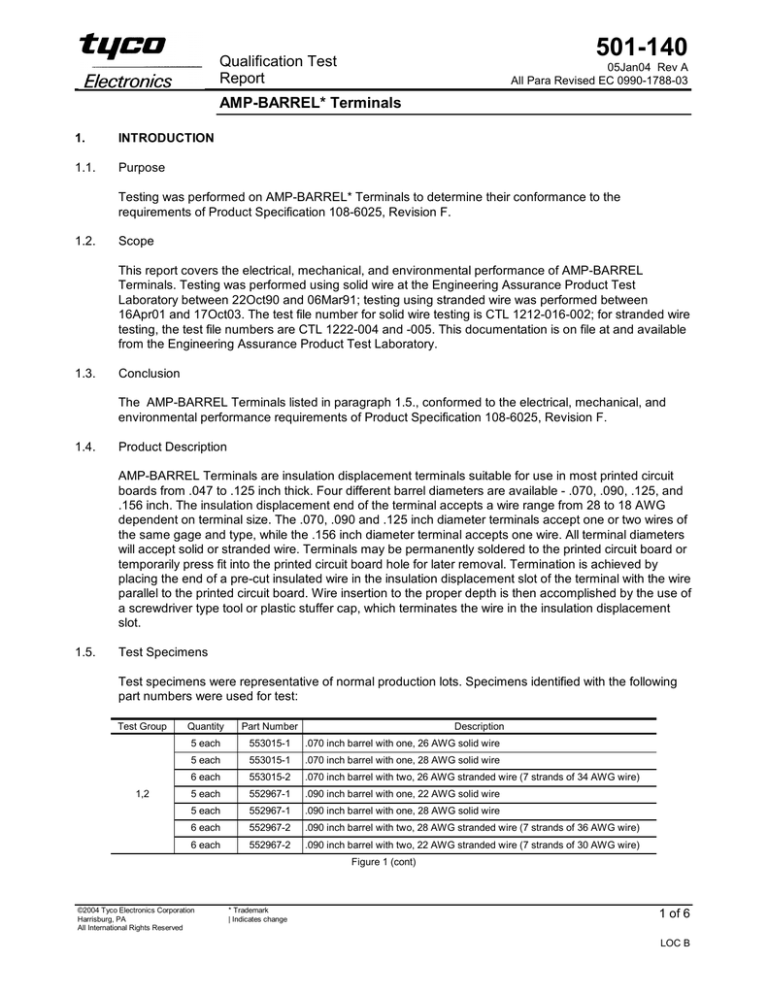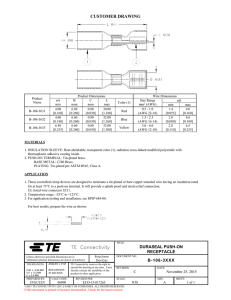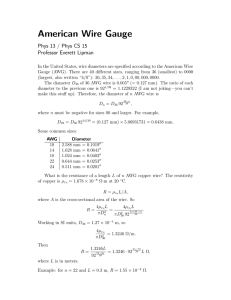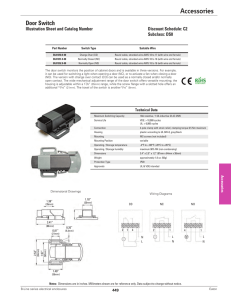
501-140
Qualification Test
Report
05Jan04 Rev A
All Para Revised EC 0990-1788-03
AMP-BARREL* Terminals
1.
INTRODUCTION
1.1.
Purpose
Testing was performed on AMP-BARREL* Terminals to determine their conformance to the
requirements of Product Specification 108-6025, Revision F.
1.2.
Scope
This report covers the electrical, mechanical, and environmental performance of AMP-BARREL
Terminals. Testing was performed using solid wire at the Engineering Assurance Product Test
Laboratory between 22Oct90 and 06Mar91; testing using stranded wire was performed between
16Apr01 and 17Oct03. The test file number for solid wire testing is CTL 1212-016-002; for stranded wire
testing, the test file numbers are CTL 1222-004 and -005. This documentation is on file at and available
from the Engineering Assurance Product Test Laboratory.
1.3.
Conclusion
The AMP-BARREL Terminals listed in paragraph 1.5., conformed to the electrical, mechanical, and
environmental performance requirements of Product Specification 108-6025, Revision F.
1.4.
Product Description
AMP-BARREL Terminals are insulation displacement terminals suitable for use in most printed circuit
boards from .047 to .125 inch thick. Four different barrel diameters are available - .070, .090, .125, and
.156 inch. The insulation displacement end of the terminal accepts a wire range from 28 to 18 AWG
dependent on terminal size. The .070, .090 and .125 inch diameter terminals accept one or two wires of
the same gage and type, while the .156 inch diameter terminal accepts one wire. All terminal diameters
will accept solid or stranded wire. Terminals may be permanently soldered to the printed circuit board or
temporarily press fit into the printed circuit board hole for later removal. Termination is achieved by
placing the end of a pre-cut insulated wire in the insulation displacement slot of the terminal with the wire
parallel to the printed circuit board. Wire insertion to the proper depth is then accomplished by the use of
a screwdriver type tool or plastic stuffer cap, which terminates the wire in the insulation displacement
slot.
1.5.
Test Specimens
Test specimens were representative of normal production lots. Specimens identified with the following
part numbers were used for test:
Test Group
1,2
Quantity
Part Number
5 each
553015-1
.070 inch barrel with one, 26 AWG solid wire
Description
5 each
553015-1
.070 inch barrel with one, 28 AWG solid wire
6 each
553015-2
.070 inch barrel with two, 26 AWG stranded wire (7 strands of 34 AWG wire)
5 each
552967-1
.090 inch barrel with one, 22 AWG solid wire
5 each
552967-1
.090 inch barrel with one, 28 AWG solid wire
6 each
552967-2
.090 inch barrel with two, 28 AWG stranded wire (7 strands of 36 AWG wire)
6 each
552967-2
.090 inch barrel with two, 22 AWG stranded wire (7 strands of 30 AWG wire)
Figure 1 (cont)
©2004 Tyco Electronics Corporation
Harrisburg, PA
All International Rights Reserved
* Trademark
| Indicates change
1 of 6
LOC B
501-140
Test Group
1,2
3,4
Quantity
Part Number
5 each
552699-1
.125 inch barrel with one, 28 AWG solid wire
Description
5 each
552699-1
.125 inch barrel with one, 18 AWG solid wire
6 each
552699-2
.125 inch barrel with two, 28 AWG stranded wire (7 strands of 36 AWG wire)
6 each
552699-2
.125 inch barrel with two, 18 AWG stranded wire (7 strands of 26 AWG wire)
6 each
552699-2
.125 inch barrel with two, 18 AWG stranded wire (19 strands of 30 AWG wire)
5 each
552770-1
.156 inch barrel with one, 24 AWG solid wire
5 each
552770-1
.156 inch barrel with one, 18 AWG solid wire
6 each
552770-2
.156 inch barrel with one, 24 AWG stranded wire (7 strands of 32 AWG wire)
6 each
552770-2
.156 inch barrel with one, 18 AWG stranded wire (7 strands of 26 AWG wire)
6 each
552770-2
.156 inch barrel with one, 18 AWG stranded wire (19 strands of 30 AWG wire)
5 each
553015-1
.070 inch barrel with one, 26 AWG solid wire
5 each
553015-1
.070 inch barrel with one, 28 AWG solid wire
6 each
553015-2
.070 inch barrel with two, 26 AWG stranded wire (7 strands of 34 AWG wire)
5 each
552967-1
.090 inch barrel with one, 22 AWG solid wire
5 each
552967-1
.090 inch barrel with one, 28 AWG solid wire
6 each
552967-2
.090 inch barrel with two, 28 AWG stranded wire (7 strands of 36 AWG wire)
6 each
552967-2
.090 inch barrel with two, 22 AWG stranded wire (7 strands of 30 AWG wire)
5 each
552699-1
.125 inch barrel with one, 28 AWG solid wire
5 each
552699-1
.125 inch barrel with one, 18 AWG solid wire
6 each
552699-2
.125 inch barrel with two, 28 AWG stranded wire (7 strands of 36 AWG wire)
6 each
552699-2
.125 inch barrel with two, 18 AWG stranded wire (7 strands of 26 AWG wire)
5 each
552770-1
.156 inch barrel with one, 24 AWG solid wire
5 each
552770-1
.156 inch barrel with one, 18 AWG solid wire
6 each
552770-2
.156 inch barrel with one, 24 AWG stranded wire (7 strands of 32 AWG wire)
6 each
552770-2
.156 inch barrel with one, 18 AWG stranded wire (7 strands of 26 AWG wire)
Figure 1 (end)
1.6.
Environmental Conditions
Unless otherwise stated, the following environmental conditions prevailed during testing:
!
!
Rev A
Temperature:
Relative Humidity:
15 to 35/C
25 to 75%
2 of 6
501-140
1.7.
Qualification Test Sequence
Test or Examination
1
2
3
4
Initial examination of product
1
1
1
1
Low level contact resistance
2,5
2,4
2,5
Temperature rise vs current
3
Current cycling
2
Vibration
3
Mechanical shock, half-sine
4
Thermal shock
3
Humidity-temperature cycling
4
Temperature life
3
Final examination of product
NOTE
(a)
(b)
6
5
6
4
See paragraph 1.5.
Numbers indicate sequence in which tests are performed.
Figure 2
2.
SUMMARY OF TESTING
2.1.
Initial Examination of Product - All Test Groups
All specimens submitted for testing were representative of normal production lots. A Certificate of
Conformance was issued by Product Assurance. Specimens were visually examined and no evidence
of physical damage detrimental to product performance was observed.
2.2.
Low Level Contact Resistance - Test Groups 1, 2 and 3
All low level contact resistance measurements, taken at 100 milliamperes maximum and 20 millivolts
maximum open circuit voltage had a change in resistance ()R) of less than 5 milliohms after testing.
2.3.
Temperature Rise vs Current - Test Group 4
All specimens had a temperature rise less than 30/C above ambient when tested at 125% of the DC
current shown in Figure 3.
Wire Size
(AWG
18
19
20
22
24
26
28
Rated Current
(amperes)
7.5
6.5
6.0
5.0
4.0
2.5
1.5
Figure 3
Rev A
3 of 6
501-140
2.4.
Current Cycling - Test Group 4
No evidence of physical damage was visible as a result of 500 cycles of current cycling.
2.5.
Vibration - Test Group 1
No discontinuities were detected during vibration testing. Following vibration testing, no cracks, breaks,
or loose parts on the specimens were visible.
2.6.
Mechanical Shock, Half-sine - Test Group 1
No discontinuities were detected during mechanical shock testing. Following mechanical shock testing,
no cracks, breaks, or loose parts on the specimens were visible.
2.7.
Thermal Shock - Test Group 3
No evidence of physical damage was visible as a result of thermal shock testing.
2.8.
Humidity-temperature Cycling - Test Group 3
No evidence of physical damage was visible as a result of humidity-temperature cycling.
2.9.
Temperature Life - Test Group 2
No evidence of physical damage was visible as a result of temperature life testing.
2.10.
Final Examination of Product - All Test Groups
Specimens were visually examined and no evidence of physical damage detrimental to product
performance was observed.
3.
TEST METHODS
3.1.
Initial Examination of Product
A Certificate of Conformance was issued stating that all specimens in this test package were produced,
inspected, and accepted as conforming to product drawing requirements, and were manufactured using
the same core manufacturing processes and technologies as production parts.
3.2.
Low Level Contact Resistance
Low level contact resistance measurements were made using a 4 terminal measuring technique (Figure
4). The test current was maintained at 100 milliamperes maximum with a 20 millivolt maximum open
circuit voltage.
Rev A
4 of 6
501-140
Figure 4
Low Level Contact Resistance Measurement Points
3.3.
Temperature Rise vs Current
Thermocouples were attached to individual contacts to measure their temperatures. Specimens were
connected in a series circuit and energized at 125% of the DC current shown in Figure 3. When the
temperature rise of 3 consecutive readings taken at 5 minute intervals did not differ by more than 1/C,
the temperature measurement was recorded. The ambient temperature was then subtracted from this
measured temperature to find the temperature rise.
3.4.
Current Cycling
Specimens were connected in a series circuit and subjected to 500 cycles of current cycling. Each cycle
consisted of being energized for 15 minutes at 150% of the DC current shown in Figure 3 followed by 15
minutes un-energized. Temperatures were monitored just prior to the end of each energized portion of
the cycle.
3.5.
Vibration, Sinusoidal
Specimens were subjected to sinusoidal vibration, having a simple harmonic motion with an amplitude
of 0.06 inch, double amplitude. The vibration frequency was varied uniformly between the limits of 10
and 55 Hz and returned to 10 Hz in 1 minute. This cycle was performed 120 times in each of 3 mutually
perpendicular planes for a total vibration time of 6 hours. Specimens were monitored for discontinuities
of 1 microsecond or greater using a current of 100 milliamperes DC. The connector wire assemblies
were secured straight out from the connector at the edge of the printed circuit board.
3.6.
Mechanical Shock, Half-sine
Specimens were subjected to a mechanical shock test having a half-sine waveform of 50 gravity units (g
peak) and a duration of 11 milliseconds. Three shocks in each direction were applied along the 3
mutually perpendicular planes for a total of 18 shocks. Specimens were monitored for discontinuities of
1 microsecond or greater using a current of 100 milliamperes DC. The connector wire assemblies were
secured straight out from the connector at the edge of the printed circuit board.
Rev A
5 of 6
501-140
3.7.
Thermal Shock
Specimens were subjected to 25 cycles of thermal shock with each cycle consisting of 30 minute dwells
at -55 and 85/C. The transition between temperatures was less than 1 minute.
3.8.
Humidity-temperature Cycling
Specimens were exposed to 10 cycles of humidity-temperature cycling. Each cycle lasted 24 hours and
consisted of cycling the temperature between 25 and 65/C twice while maintaining high humidity (Figure
5).
Figure 5
Typical Humidity-Temperature Cycling Profile
3.9.
Temperature Life
Specimens were exposed to a temperature of 85/C for 792 hours (33 days).
3.10.
Final Examination of Product
Specimens were visually examined for evidence of physical damage detrimental to product
performance.
Rev A
6 of 6



